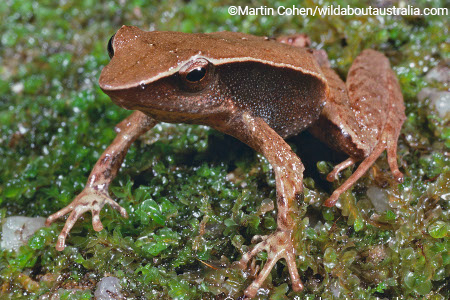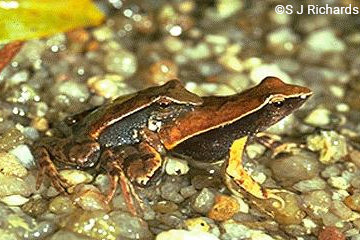About
With only three individuals reported since 1994, there is doubt as to whether this species is still surviving in the wild.
The sharp snouted day frog is the most visually distinctive member of its genus. It is a small frog with a narrow wedge-shaped snout that is acutely pointed and protrudes well beyond the lower jaw. There appears to be two different types of call, one likened to a metallic tinkling, repeated a number of times in quick succession, and the other more like a chirp. Male sharp snouted day frogs seem to form territories, although this may be a response to the dramatic population declines, and resultant low numbers of females.
The Taudactylus genus of frogs, to which this species belongs, diverged from all other amphibians over 65 million years ago. This means this group of frogs has been evolving in isolation since before the extinction of the dinosaurs!
The sharp snouted day frog is just one species out of many in northeastern Australia which have been affected by the chytrid fungus. The disease is thought to have caused a series of frog population declines and extinctions across the region. A relatively large proportion of this species’ habitat is covered by national parks, but the lack of sightings of the species since 1997 indicates the sharp snouted day frog may now be extinct.
- Order: Anura
- Family: Myobatrachidae
- Population: Possibly extinct
- Trend: decreasing
- Size: 22-30mm
EDGE Score
Distribution
This species is Endemic to Australia, with the majority of its’ former range in northern Queensland and now only in the northern boundary of its distribution. The frog has been found at altitudes of 300-1300 metres above sea level.
Habitat and Ecology
This species is active during the day and can be found basking in the sun and is generally found among rocks and leaf litter along the edges of fast-flowing rainforest stream, although it may be found some distance from the water. Breeding takes place throughout the year, when females lay 25 to 40 large (up to 2.7 mm diameter) unpigmented eggs in clumps positioned on the base of rocks on or below the waterline in shaded parts of streams. The tadpoles dwell at the bottom of water bodies, inhabiting debris in pools or areas of slow flowing rainforest streams.

